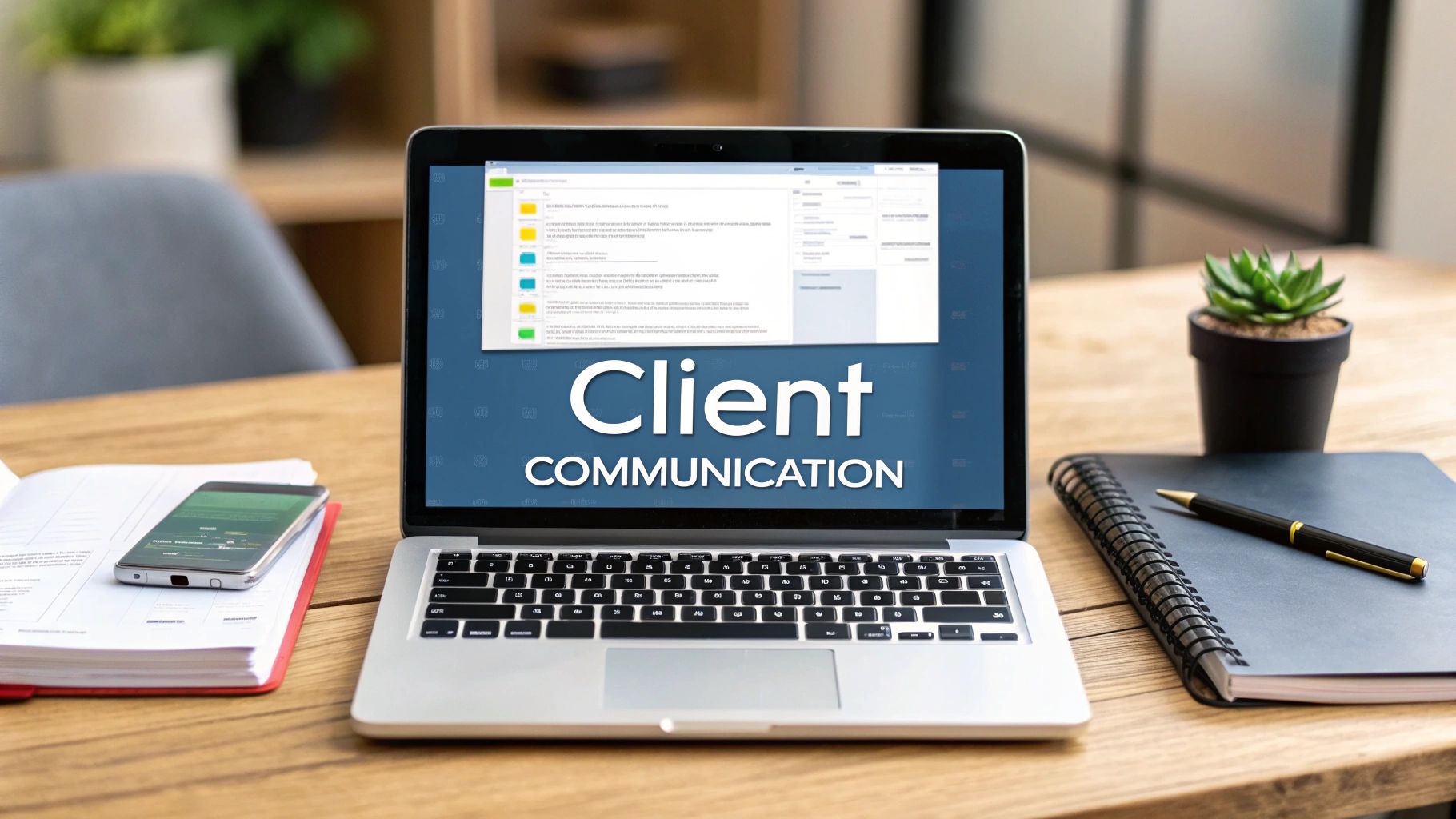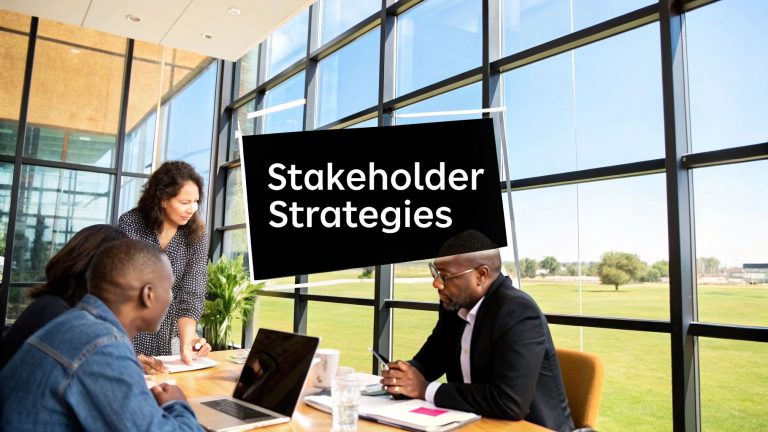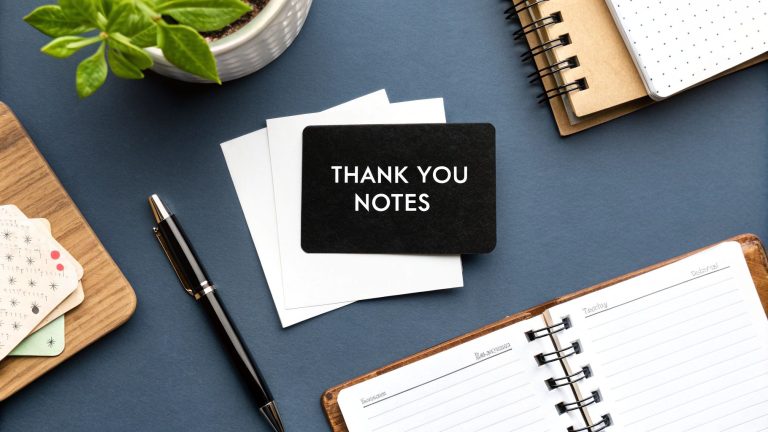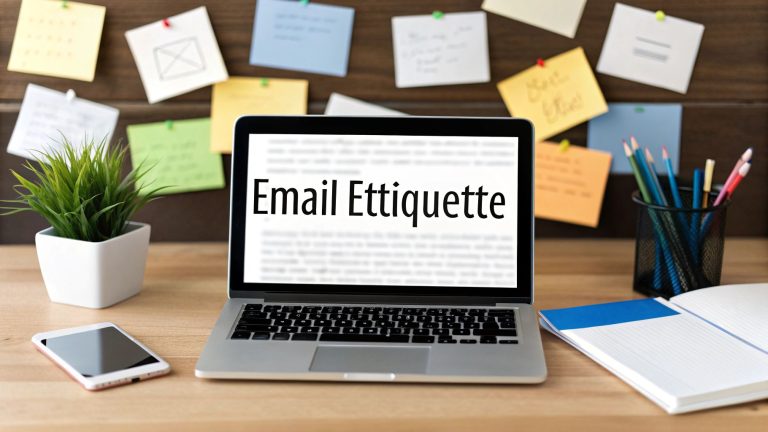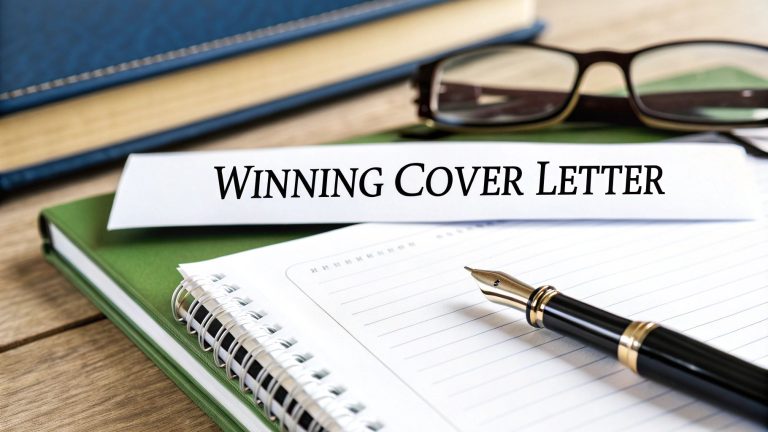In today's competitive landscape, the quality of your client communication is as important as the quality of your work. It's the bedrock of trust, the driver of project success, and the key to fostering long-term loyalty. But what does exceptional client communication truly look like? It moves far beyond simply sending a weekly update or a "just checking in" email. It is a strategic practice that requires intention, clarity, and empathy.
Too often, projects derail not from a lack of technical skill, but from simple misunderstandings, misaligned expectations, or a fundamental failure to connect on a human level. A vague email can lead to costly rework, a missed phone call can erode confidence, and a defensive tone can fracture a partnership permanently. Mastering these interactions is what separates good service providers from indispensable partners. This guide is designed to provide a definitive, actionable blueprint of client communication best practices that you can implement immediately.
We will break down eight powerful strategies that serve as the foundation for transforming your client relationships. Forget generic advice; each point is crafted to prevent common pitfalls, build unwavering confidence, and help you deliver outstanding results that speak for themselves. You will learn how to:
- Establish clear expectations from day one.
- Adapt your style to fit individual client needs.
- Navigate difficult conversations with transparency.
- Maintain proactive and consistent contact.
By implementing these client communication best practices, you will move your interactions from merely transactional to truly collaborative, ensuring every project is a success for both you and your client. Let's dive in.
1. Set Clear Communication Expectations Early
One of the most foundational client communication best practices is establishing clear expectations from the very beginning. Ambiguity is the enemy of a healthy client relationship. By proactively defining the rules of engagement, you prevent misunderstandings, manage expectations, and create a predictable, professional environment for everyone involved. This means leaving nothing to chance regarding how, when, and where communication will happen.
A formal communication plan, established during onboarding, acts as a definitive guide. It outlines everything from preferred contact channels (email vs. phone vs. project management tool) to expected response times for non-urgent inquiries. This simple document eliminates the guesswork that often leads to client frustration or scope creep, setting the stage for a partnership built on mutual respect and clarity.

Why This Is a Critical First Step
Defining communication protocols early is a proactive strategy that pays long-term dividends. It demonstrates professionalism and shows the client you value both their time and your own. When clients know what to expect, they feel more secure and are less likely to send follow-up emails or make anxious phone calls. This practice builds trust and establishes you as an organized, reliable partner.
For example, a marketing agency like HubSpot often includes a "communication charter" in its client onboarding package. This document might state that all project-related discussions will happen within a specific project management tool, with a guaranteed 24-hour response time on business days. This prevents critical details from getting lost in various email inboxes and sets a clear standard for responsiveness.
How to Implement This Practice
Getting this right involves more than just a quick conversation. It requires a tangible agreement that both parties can refer back to. Here are some actionable steps:
- Create a Written Communication Agreement: Draft a simple, one-page document outlining all communication norms. Include sections for primary points of contact, preferred communication channels, standard response times (e.g., 4 hours for urgent, 24 hours for non-urgent), and the schedule for regular check-in meetings.
- Include It in Your Contract: For maximum authority, integrate these communication terms directly into your official contract or Statement of Work (SOW). This makes the agreement legally binding and underscores its importance.
- Use a Client Onboarding Checklist: Make discussing communication a mandatory step in your onboarding process. A checklist ensures you cover all key points, from confirming the client's preferred way to receive updates to defining what constitutes an "emergency."
- Hold a Kickoff Meeting: Dedicate a portion of your project kickoff meeting specifically to walking the client through the communication plan. This allows you to answer questions and get their verbal buy-in, ensuring everyone is on the same page before any work begins.
2. Practice Active Listening and Ask Clarifying Questions
Another crucial element of effective client communication best practices is mastering the art of active listening. This goes far beyond simply hearing the words a client says; it involves fully concentrating on their message, understanding the context and underlying emotions, and responding thoughtfully. Active listening is about ensuring you comprehend the real need behind the request, which prevents the costly misunderstandings that arise from making assumptions.
This practice demonstrates genuine respect for the client's perspective and builds deep, lasting trust. By asking clarifying questions, you show that you are engaged and committed to delivering precisely what they need, not just what you think they want. It transforms a transactional conversation into a collaborative partnership focused on achieving shared goals.

Why This Is a Critical Skill
Active listening is a strategic tool for uncovering a project's core objectives. Clients may not always know how to articulate their exact needs or may focus on a proposed solution rather than the root problem. By listening actively and asking probing questions, you can dig deeper to identify the true measure of success and prevent wasted effort on the wrong priorities. This skill is fundamental to delivering value and achieving high client satisfaction.
For instance, the global design firm IDEO famously uses a technique called the "Five Whys," where they repeatedly ask "why" to drill down past surface-level requests and uncover the client's fundamental needs. Similarly, Salesforce trains its account managers in specific active listening techniques, which has been shown to result in significantly higher client satisfaction scores by ensuring a more profound understanding of customer challenges.
How to Implement This Practice
Integrating active listening into your daily interactions requires conscious effort and specific techniques. It's a skill that can be developed and refined over time. Here are some actionable steps:
- Follow the 70/30 Rule: Aim to listen 70% of the time and speak only 30%. This ensures the focus remains on understanding the client's perspective rather than formulating your own response.
- Paraphrase and Summarize: After the client speaks, repeat back what you heard in your own words. Start with phrases like, "So, if I'm understanding correctly…" or "What I'm hearing is…" This confirms comprehension and gives the client a chance to correct any misinterpretations.
- Ask Open-Ended, Clarifying Questions: Avoid simple yes-or-no questions. Instead, use prompts like, "Help me understand more about…" or "What does success look like for you on this project?" These questions encourage detailed responses that reveal valuable insights.
- Eliminate Distractions: When on a call or in a meeting, give the client your full attention. Close unnecessary tabs, silence notifications, and avoid multitasking. This focus shows respect and improves your ability to absorb critical information.
3. Maintain Regular, Proactive Communication
One of the most impactful client communication best practices is shifting from a reactive to a proactive approach. Instead of waiting for clients to ask for updates, you should reach out with progress reports, insights, and relevant information before they feel the need to inquire. This practice establishes regular touchpoints, ensuring clients feel informed and valued throughout the entire project lifecycle, reinforcing their decision to partner with you.
Proactive communication builds confidence and prevents anxiety. When clients are kept in the loop, they trust that their project is on track and in capable hands. It demonstrates organization, accountability, and a genuine commitment to their success, transforming your role from a mere vendor into a trusted, indispensable partner.
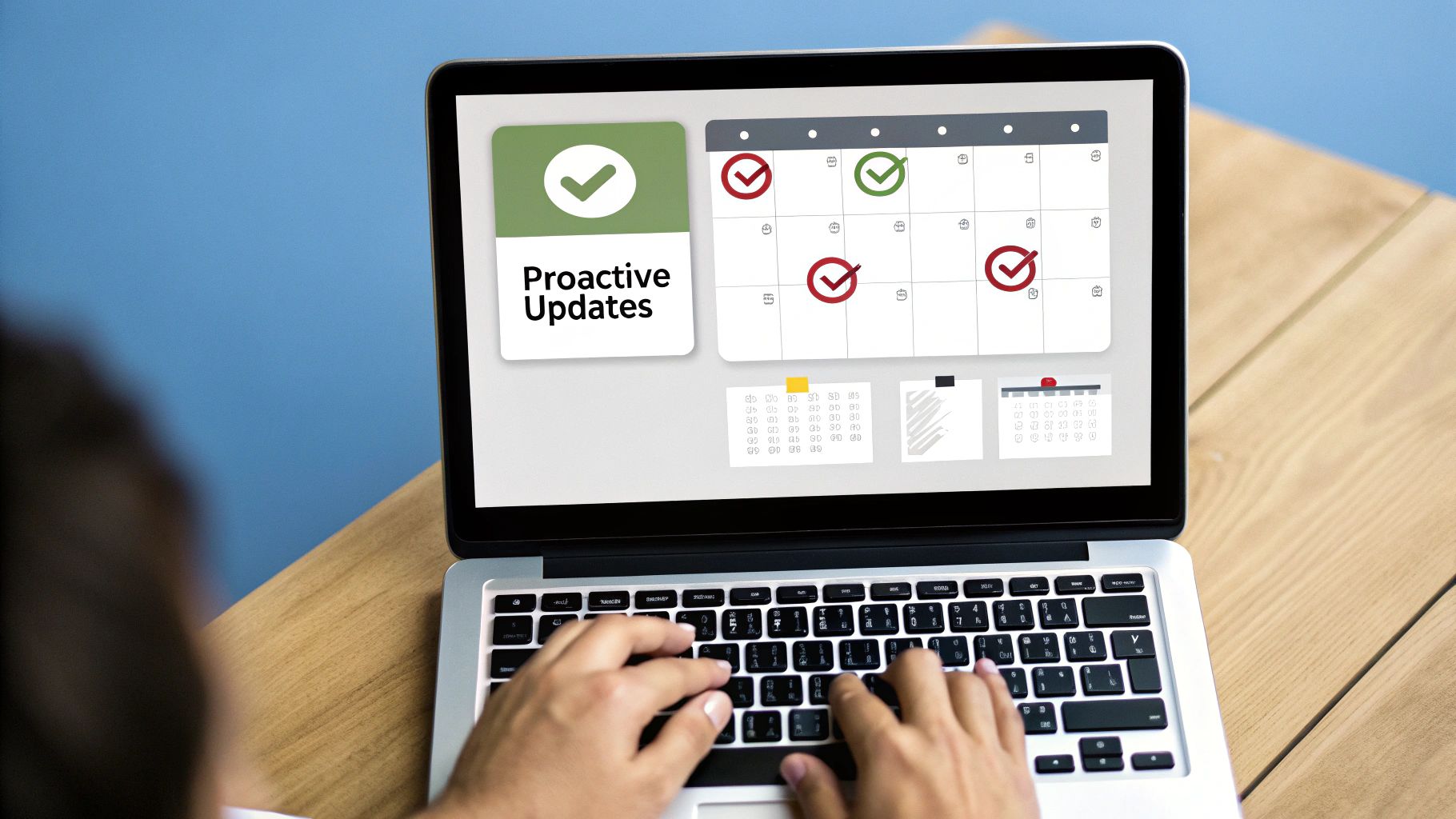
Why This Is a Critical Ongoing Strategy
Adopting a proactive mindset is essential for maintaining momentum and positive client sentiment. It follows the "no surprises" rule, which dictates that clients should never be caught off guard by unexpected news, whether good or bad. By sharing challenges as soon as they arise, you involve them in the solution and show you are managing the situation responsibly. This transparency is key to navigating bumps in the road without damaging the relationship.
For example, a software development team using Agile methodology might send a concise sprint report every two weeks. This report would highlight completed tasks, outline the goals for the next sprint, and flag any potential blockers. This consistent, predictable update keeps the client engaged and aligned with the project's progress, preventing a buildup of questions or concerns.
How to Implement This Practice
Integrating proactive communication into your workflow requires a system, not just good intentions. The goal is to make regular updates a non-negotiable part of your process. Here are actionable steps to get started:
- Schedule Recurring Check-ins: Use your calendar to set up recurring reminders for weekly or bi-weekly client updates. Treat these as mandatory appointments to ensure consistency, even during busy periods.
- Create Update Templates: To save time and maintain a professional format, develop email templates for regular progress reports. Include sections for "What We Accomplished," "What's Next," and "Action Items or Questions."
- Leverage Project Management Tools: Utilize tools like Asana, Trello, or Monday.com that can automatically generate status reports or provide clients with read-only access to a project dashboard for real-time visibility.
- Share Both Wins and Hurdles: Don't just communicate when there's a problem. Share small victories and positive progress to build momentum. When challenges do arise, present them promptly with a proposed solution. This shows you are in control and forward-thinking, even when facing issues. For additional guidance on structuring these communications, you can find examples of how to write inquiry letters that can be adapted for status updates.
4. Adapt Your Communication Style to Each Client
One of the most nuanced client communication best practices involves recognizing that a one-size-fits-all approach is ineffective. Adapting your communication style means understanding that each client has unique preferences for receiving and processing information, and then adjusting your methods accordingly. This practice demonstrates high emotional intelligence and a true client-centric mindset, making every interaction more efficient, comfortable, and productive.
This strategy goes beyond simple politeness; it's about matching the client's preferred level of detail, tone, and medium. Some clients thrive on data-heavy reports and formal emails, while others prefer quick, high-level summaries over a phone call. By mirroring their style, you build rapport faster and ensure your message is not just delivered, but truly understood.
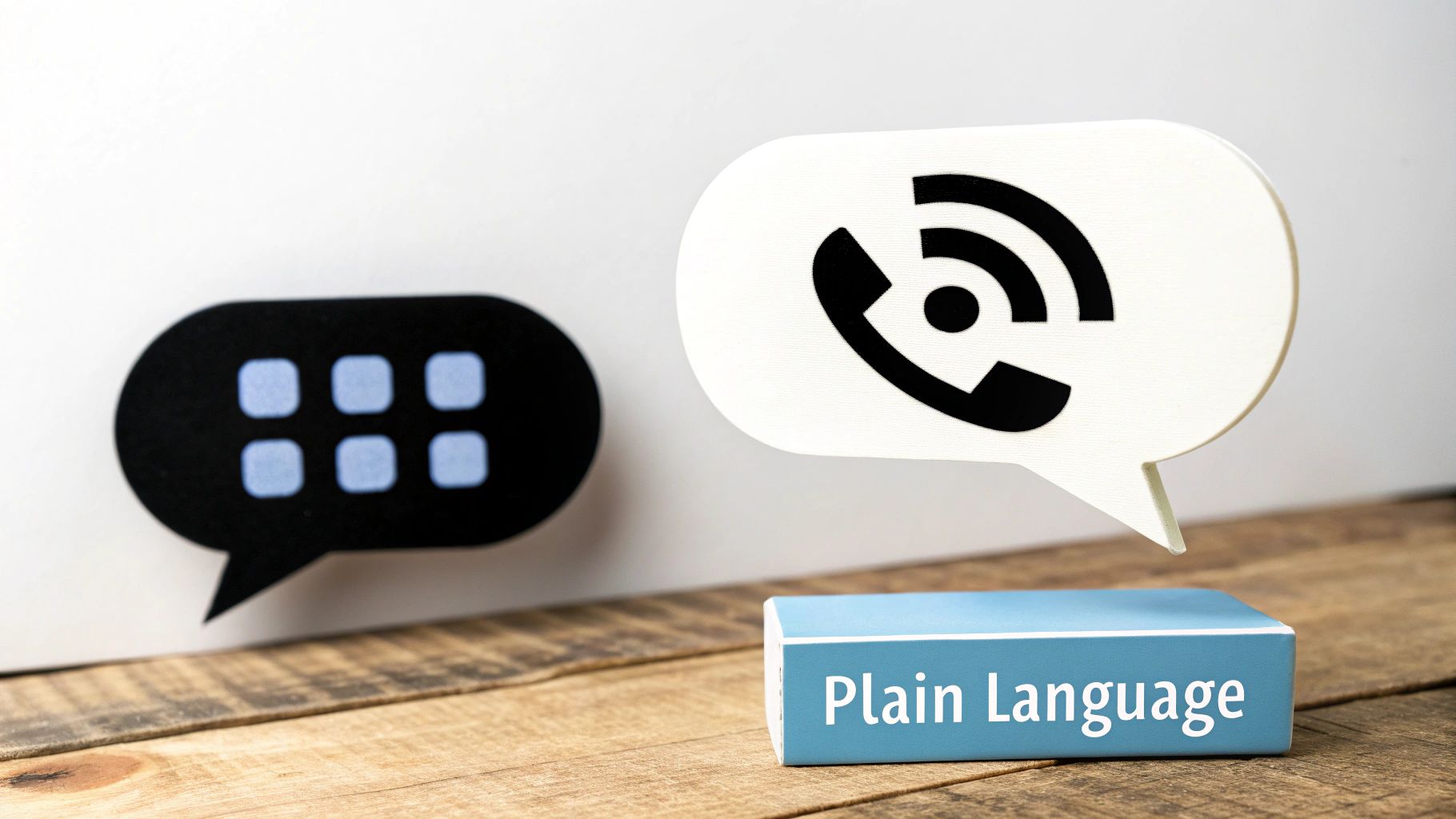
Why This Is a Critical First Step
Adapting your style shows you are listening on a deeper level. It communicates respect for the client's personality and workflow, making them feel seen and valued. This builds significant trust and can be a major differentiator between you and competitors. When communication feels effortless for the client, the entire working relationship becomes smoother and more collaborative.
For instance, consulting firms like Bain & Company are known for creating custom reporting formats tailored to each client’s executive team. If a CEO prefers visual dashboards over dense documents, the team adjusts its deliverables. Similarly, real estate giant Keller Williams coaches its agents to mirror their clients' communication pace and tone, whether they are direct and fast-paced or more relational and methodical, leading to stronger connections and better outcomes.
How to Implement This Practice
Consciously adapting your style requires observation and intentionality. Here are some actionable steps to master this skill:
- Ask Directly During Onboarding: The simplest way to know is to ask. Add a question to your kickoff meeting agenda like, "How do you prefer to receive project updates: a detailed email, a quick summary, or a phone call?"
- Observe and Mirror: Pay close attention to how your clients communicate with you. Do they use emojis and exclamation points, or are their emails formal and concise? Mirror their tone, formality, and even sentence structure to create a sense of alignment.
- Offer Communication Choices: When sending information, provide options. You could say, "I can send you the full 30-page report, or would an executive summary with key takeaways be more helpful right now?" This empowers the client and respects their time. Learn more about how tailoring your message is one of the key business communication best practices.
- Leverage Your CRM: Make notes in your CRM or client file about their specific preferences. Note things like "prefers bullet points," "hates long meetings," or "responds best to text messages for urgent items." This ensures consistency across your team.
5. Be Transparent About Challenges and Setbacks
One of the most powerful client communication best practices is embracing radical transparency, especially when things go wrong. Hiding mistakes or delays erodes trust faster than the issue itself. Being transparent means proactively sharing challenges, taking ownership of setbacks, and communicating bad news with honesty and a clear plan of action. This approach transforms a potential crisis into an opportunity to strengthen the client relationship.
Rather than waiting for the client to discover a problem, you bring it to them with context, impact analysis, and proposed solutions. This demonstrates integrity and reassures them that you are in control, even when faced with unexpected hurdles. It shifts the dynamic from one of vendor and client to one of true partnership, where both parties work together to navigate challenges.
Why This Builds Unbreakable Trust
Honesty during difficult times is the ultimate trust-builder. When you are upfront about a mistake or delay, you show respect for your client and their business. It proves you are a reliable partner who won't disappear or make excuses when problems arise. This proactive honesty prevents the client from feeling blindsided and gives them time to adjust their own plans if necessary.
For instance, software company Buffer is famous for its transparency, publicly sharing everything from revenue figures to security breach post-mortems. When they experience an outage, they don't hide it; they provide immediate, detailed updates on their progress. This level of openness, while daunting, has earned them a fiercely loyal customer base that trusts them to do the right thing, even when things go wrong.
How to Implement This Practice
Delivering bad news requires a thoughtful and structured approach. It’s about more than just admitting a problem; it’s about managing the situation professionally.
- Use the 'Headline, Impact, Solution' Framework: Start by stating the problem clearly (headline). Explain how it affects the project or their business (impact). Immediately follow up with one or more proposed solutions.
- Take Ownership Quickly: Never let a client hear bad news from a third party. As soon as a problem is identified, be the first one to communicate it. Take responsibility, even if you are only partially at fault, to show accountability.
- Choose the Right Channel: For serious issues, an email is not enough. Schedule a video call or face-to-face meeting to convey the gravity of the situation and show your personal commitment to resolving it. This also allows you to read their reaction and respond with empathy.
- Present Solutions, Not Just Problems: Never present a challenge without also presenting a way forward. Offer two or three potential solutions, along with your professional recommendation, to empower the client and show you are focused on resolution. This is a far more constructive approach than simply writing a complaint letter, which you can learn more about crafting by exploring how to write a complaint letter on Lettergenerator.co.
6. Document Everything in Writing
One of the most crucial client communication best practices is creating a permanent written record of all significant interactions. This involves documenting key decisions, agreements, scope changes, and feedback throughout a project’s lifecycle. Verbal agreements are easily forgotten or misinterpreted, but written documentation serves as a single source of truth that protects both you and your client from future disputes.
This practice transforms fleeting conversations into concrete, verifiable records. From a simple follow-up email summarizing a phone call to a formal, signed change order, written records eliminate ambiguity. They ensure that everyone has a shared understanding of what was discussed and agreed upon, creating a foundation of accountability and clarity.
Why This Is a Critical Safety Net
Maintaining a written trail is a non-negotiable risk management strategy. It provides a clear history of the project that can be referenced at any time to resolve disagreements or confirm details. When a client questions a decision made weeks ago or forgets a previously approved change, a quick search through your archives provides immediate, indisputable evidence. This practice prevents "he said, she said" scenarios and safeguards your business.
For example, a consulting firm like Deloitte never proceeds with work outside the initial scope without a formal, written change order. This document outlines the new requirements, costs, and timeline adjustments and requires the client's signature. This process ensures they are compensated for additional work and that the client is fully aware of and has approved the changes, preventing budget disputes down the line.
How to Implement This Practice
Integrating documentation into your workflow requires consistent habits and the right tools. Here are actionable steps to make it a standard procedure:
- Send Recap Emails: After every important meeting or phone call, send a summary email within 24 hours. Use clear subject lines and phrases like, "Per our conversation today…" or "Just to confirm the action items we discussed…" to formalize the record.
- Request Written Confirmation: When a decision is made, explicitly ask the client to confirm their agreement in writing. A simple request like, "Please reply to this email to confirm we're aligned on this approach," is sufficient to create a documented approval.
- Use a Formal Change Order Process: Create a standardized template for any changes to the project scope, timeline, or budget. This document should detail the change, its impact, and require a client signature before any new work begins.
- Leverage Project Management Tools: Use platforms like Basecamp or Asana where all project-related communication is automatically archived and time-stamped. This creates a centralized, searchable history of every conversation and decision.
- Organize Your Files Systematically: Store all documentation in a shared, organized system like Google Drive or SharePoint. Create a logical folder structure (e.g., by client, then by project, then by document type) so that any record can be found quickly.
7. Use Clear, Jargon-Free Language
One of the most essential client communication best practices is to use language that is simple, direct, and free of industry-specific jargon. True expertise isn't shown by using complex terminology; it's demonstrated by the ability to explain complex ideas in a way anyone can understand. This means actively avoiding acronyms and technical terms unless you are certain your client is familiar with them.
Using plain language ensures your message is received exactly as intended, preventing confusion and building client confidence. It shows respect for their time and intelligence, fostering a more inclusive and collaborative partnership. When clients understand you perfectly, they can make better, more informed decisions.
Why This Is a Critical Communication Skill
Clarity is the foundation of trust. When you speak in jargon, you create a barrier between you and the client, making them feel uninformed or intimidated. Using clear, accessible language dismantles this barrier, making clients feel like valued partners who are fully involved in the process. It eliminates the risk of misunderstandings that can lead to project delays or incorrect outcomes.
For example, tech companies like Apple excel at this by describing sophisticated technology with simple, benefit-oriented language. Instead of listing processor speeds, they say a device is “blazingly fast.” This approach focuses on the user's experience rather than the technical specifications, a principle that can be applied to any industry to make communication more effective.
How to Implement This Practice
Adopting jargon-free language requires a conscious effort to simplify your communication style. Here are actionable steps to ensure your message is always understood:
- Apply the "Grandmother Test": Before sending an email or giving an update, ask yourself if someone outside your industry, like your grandmother, would understand it. If the answer is no, revise it until it's clear.
- Replace Complex Words with Simple Ones: Swap out business jargon for everyday language. For instance, use "help" instead of "facilitate," "use" instead of "utilize," and "plan" instead of "strategize." For more tips, you can explore guides on professional letter writing.
- Use Active Voice: Write in the active voice to make your sentences more direct and powerful. Say, "We completed the report" instead of the passive "The report was completed by us."
- Leverage Readability Tools: Use tools like Hemingway Editor to check the reading level of your writing. Aim for a grade level that is accessible to a broad audience, typically around the 8th grade, to ensure maximum clarity.
8. Establish and Respect Boundaries
A key component of sustainable client communication best practices is setting and maintaining firm professional boundaries. This involves clearly defining your availability, the scope of your work, and the appropriate channels for communication. Establishing these limits protects both you and the client from burnout, prevents scope creep, and ensures the professional relationship remains healthy and productive over the long term.
Setting boundaries isn't about being difficult or unavailable; it’s about creating a predictable and respectful working structure. When clients understand your working hours and response time expectations, they can plan accordingly. This proactive clarity prevents the pressure to be "always on" and fosters a partnership built on mutual respect for each other's time and well-being.
Why This Is a Critical Practice
Without clear boundaries, you risk creating an expectation of 24/7 availability, which is a fast track to burnout and resentment. It also blurs the lines between professional and personal time, ultimately diminishing the quality of your work. Respecting boundaries demonstrates confidence in your processes and values, showing the client that you manage your time effectively to deliver the best results during dedicated hours.
For instance, top consulting firms often have formal policies discouraging after-hours or weekend client communication for non-emergencies. They know that well-rested, focused consultants deliver superior work. Similarly, design agencies like Pentagram are famous for clearly defining the number of revisions included in a contract, which is a boundary that protects the project's scope and budget.
How to Implement This Practice
Effectively setting boundaries requires clear communication and consistent reinforcement. It’s a professional standard, not a personal preference. Here are some actionable steps to get started:
- State Boundaries Positively: Frame your availability in a positive light. Instead of saying, “Don’t contact me on weekends,” say, “My business hours are Monday to Friday, 9 AM to 5 PM, to ensure I can give your project my full attention.”
- Include Boundaries in Your Contract: Formalize your working hours, communication protocols, and scope limits directly in your contract or Statement of Work. This gives you a legal and professional document to refer back to if boundaries are crossed.
- Use Automation to Reinforce Limits: Set up email autoresponders for after-hours messages that acknowledge receipt and state when the client can expect a reply. Similarly, use scheduling tools like Calendly to let clients book meetings only within your available time slots.
- Address Violations Professionally: If a client repeatedly contacts you outside of established hours for non-urgent matters, address it politely but firmly. A simple, "I saw your message from Saturday evening. I'm reviewing it now and will get back to you by EOD as per my standard response time" can gently reset expectations.
Client Communication Best Practices Comparison
| Practice | Implementation Complexity | Resource Requirements | Expected Outcomes | Ideal Use Cases | Key Advantages |
|---|---|---|---|---|---|
| Set Clear Communication Expectations Early | Medium (requires upfront planning) | Moderate (time to document and review) | Reduced misunderstandings; improved workflow | New client relationships; project kickoffs | Accountability; minimized client anxiety |
| Practice Active Listening and Ask Clarifying Questions | Medium-High (skill development needed) | High (time and mental energy per meeting) | Stronger trust; fewer revisions; clearer needs | Discovery sessions; complex client interactions | Builds rapport; uncovers hidden needs |
| Maintain Regular, Proactive Communication | Medium (requires systems and discipline) | Moderate-High (time for updates and tools) | Increased client confidence; fewer status queries | Ongoing projects; long-term client management | Builds trust; prevents surprises |
| Adapt Your Communication Style to Each Client | High (requires client assessment and flexibility) | Moderate (time to learn preferences) | Better comprehension; personalized engagement | Diverse client base; relationship management | Reduces friction; strengthens rapport |
| Be Transparent About Challenges and Setbacks | Medium (requires honesty and protocols) | Moderate (time to communicate promptly) | Builds trust; prevents crises escalation | Projects with risks; crisis management | Integrity; collaborative problem-solving |
| Document Everything in Writing | Medium-High (organizational effort) | High (ongoing documentation and storage) | Clear records; legal protection | Regulated industries; complex projects | Accountability; dispute prevention |
| Use Clear, Jargon-Free Language | Medium (effort to simplify language) | Moderate (time to edit and test) | Better comprehension; fewer clarifications | Client communications; technical explanations | Inclusive communication; reduces errors |
| Establish and Respect Boundaries | Medium (requires policy setting and enforcement) | Moderate (communication and monitoring) | Prevents burnout; sustainable relationships | High-demand clients; freelance and consultative work | Work-life balance; limits scope creep |
Putting It All Together: Communication as a Competitive Advantage
We’ve explored a comprehensive set of strategies designed to elevate your client interactions from simple transactions to meaningful partnerships. The journey through these client communication best practices isn't about memorizing a script; it's about fundamentally shifting your approach to prioritize clarity, empathy, and consistency in every exchange.
From setting clear expectations in the initial kickoff meeting to practicing active listening during a feedback call, each practice serves a distinct but interconnected purpose. Maintaining proactive communication prevents anxiety and builds trust, while adapting your style shows you value the client as an individual. Being transparent about setbacks and documenting everything in writing protects both parties and reinforces your integrity. Ultimately, using clear, jargon-free language and respecting boundaries ensures that every interaction is productive and professional.
From Theory to Daily Practice
Mastering these skills is an ongoing process, not a one-time checklist. The true power of these concepts emerges when they become ingrained habits in your daily workflow. The goal is to make exceptional communication so second nature that it becomes a defining characteristic of your brand or professional identity.
Think of it this way: every email, every report, and every phone call is an opportunity. It's a chance to either strengthen the client relationship or introduce friction. By consistently applying these principles, you ensure that each touchpoint contributes positively to the client’s experience, building a foundation of trust that can weather any challenge.
To begin integrating these ideas, avoid overwhelming yourself. Instead of trying to implement all eight practices at once, choose one or two that address your most immediate challenges.
- If you often face scope creep: Focus intently on Setting Clear Communication Expectations Early and Documenting Everything in Writing.
- If you've received feedback about being hard to reach: Prioritize Maintaining Regular, Proactive Communication.
- If misunderstandings are common: Double down on Active Listening and using Clear, Jargon-Free Language.
Start small. Dedicate the next two weeks to mastering your chosen practices. Set reminders, review your emails before sending, and consciously ask clarifying questions in meetings. Once these actions feel natural, you can layer in another practice. This iterative approach makes sustainable improvement feel achievable rather than daunting.
Your Communication Is Your Brand
In a competitive market, clients have more choices than ever. While the quality of your work is paramount, the quality of your communication is what truly sets you apart. It is the framework that supports the entire client relationship. Excellent communication minimizes friction, clarifies objectives, and makes clients feel valued and understood. This is what transforms a one-time project into a long-term partnership and turns satisfied customers into vocal advocates for your business.
By committing to these client communication best practices, you are not just improving a soft skill; you are building a powerful competitive advantage. You are investing in a system that fosters loyalty, encourages referrals, and drives sustainable growth. Let every interaction be a testament to your professionalism, care, and unwavering commitment to your clients' success.
Ready to streamline your professional correspondence and ensure every message hits the right mark? The AI Letter Generator can help you craft clear, concise, and empathetic client communications, from follow-up emails to formal project updates, in a fraction of the time. Visit the AI Letter Generator to see how you can elevate your communication today.
